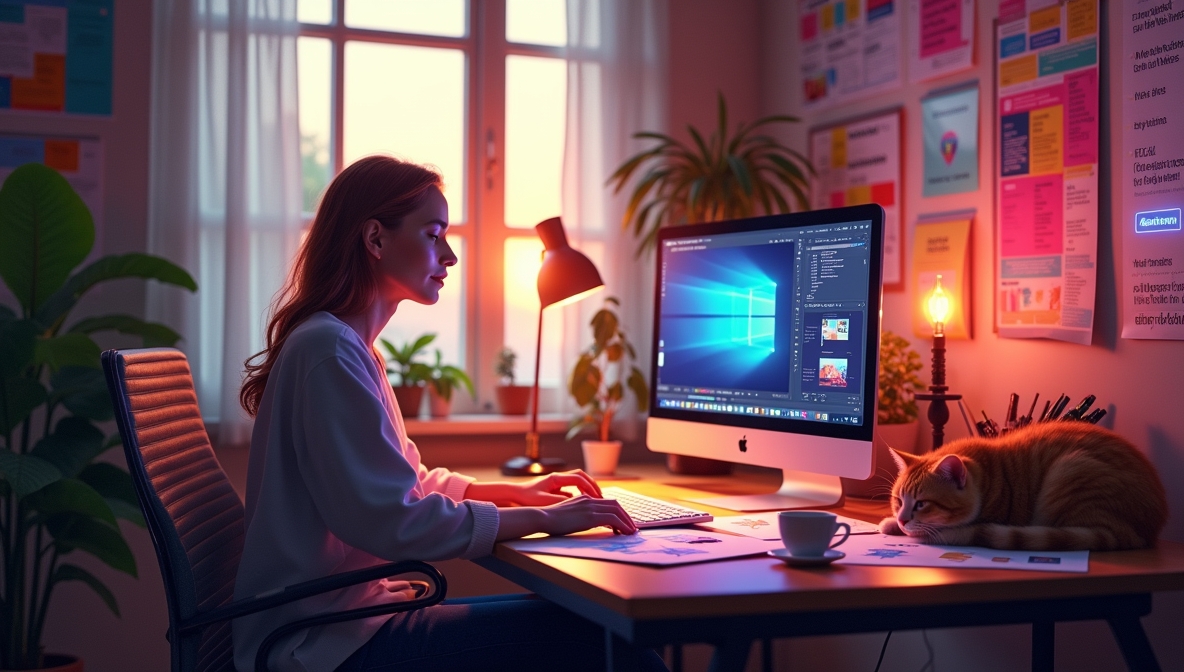You’re nudging pixels, refining prototypes, maybe even sitting in another meeting about synergy… and a little voice whispers, “What if I just… did this for myself?” The thought of ditching the 9-to-5 (or maybe just finding better work) for the world of freelance UI design jobs is tempting. Freedom! Flexibility! Piles of cash raining down! Okay, maybe slow down on that last one.
Going freelance in UI design is a totally viable path, maybe even a lucrative one. But let’s cut through the Instagram hype and talk about what it actually looks like in 2025 – the good, the slightly terrifying, and how you might actually pull it off.
Quick Nav: What We’ll Cover
- Why Freelance UI Isn’t Just a Pipe Dream Right Now
- What’s the Real Deal with Freelance UI Money and Freedom?
- Okay, But Where Do I Actually Find These Gigs?
- Making Yourself the Obvious Choice (Not Just Another Portfolio)
- Quick Answers to Big Questions
- Alright, Feeling Inspired (or Terrified)? What Now?
Why Freelance UI Isn’t Just a Pipe Dream Right Now
First off, you’re not alone in considering this. The freelance world is massive. We’re talking about roughly 1.57 billion people globally doing some kind of freelance work. That’s nearly half the planet’s workforce! And the market specifically for freelancers? It hit $455 billion in 2023 and is cruising towards $500 billion by 2025. So yeah, companies are definitely hiring outside the traditional full-time box, especially as the freelance market value demonstrates significant growth.
Why the boom, especially for UI designers? Businesses everywhere finally get it: a slick, user-friendly digital presence isn’t a nice-to-have, it’s essential. From startups needing an MVP designed yesterday to established companies revamping their ancient apps, the demand for skilled UI designers is strong, with projections showing solid growth.
What’s the Real Deal with Freelance UI Money and Freedom?
Let’s talk cash. Rates for freelance UI designers swing wildly, typically anywhere from $20 to $150 per hour. Why the huge range? Experience, location (though less than you’d think), project complexity, and frankly, how well you negotiate all play a part. For context, the median annual salary for a traditionally employed UI designer in the U.S. hovered around $89,877 as of early 2025, giving you a benchmark.
Here’s a kicker: freelancers can often command higher hourly rates, sometimes 20-30% more than their salaried counterparts for the same work. Why? Companies save on benefits, office space, and long-term commitment. They pay a premium for your specific skills, exactly when they need them.
But it’s not just about potentially higher earnings. Flexibility is the other big draw. Take Lisa, a single mom out in California. She needed a way to balance work and family life that a traditional job just couldn’t offer. She shifted to freelancing, saw a huge demand for designers who could handle slick UI animations, and really leaned into learning that skill. Now? She’s pulling in over $85,000 a year working part-time. Seriously. Her story shows it’s not just about trading time for money, but strategically positioning your skills where the demand (and budget) is high.
Hold Up—Is Freelancing Really Better Paid?
Okay, let’s unpack that potentially higher earning thing. While the hourly rate can be higher, remember you’re covering your own taxes (ouch!), health insurance (double ouch!), software subscriptions, and retirement savings. Plus, there’s unpaid time spent finding clients, managing invoices (sometimes chasing them… let’s be real), and handling your own admin. It can be more lucrative, especially if you’re disciplined and efficient, but don’t forget the hidden costs of being your own boss.
Of course, the flip side is the infamous “feast or famine” cycle. Some months you might be drowning in projects (and cash), others… crickets. Building a steady stream of work takes time and effort. It’s not always glamorous, and sometimes “setting your own hours” means wrestling with a Figma bug at 1 AM because inspiration (or blind panic) struck.
Okay, But Where Do I Actually Find These Gigs?
This is the million-dollar question, right? Luckily, the digital age offers plenty of avenues:
- Freelance Platforms: Sites like Upwork, Fiverr (especially Fiverr Pro for higher-level gigs), and Toptal (which rigorously vets talent) are classic starting points. They connect freelancers with clients actively looking for help. These platforms handle payments and contracts, which can be a relief, but they also take a cut.
- Niche Job Boards: Look for design-specific job boards (like Dribbble Jobs or Working Not Working) which often feature high-quality freelance or contract roles.
- Networking (Groan, I Know): Don’t underestimate the power of your existing network. Let former colleagues, classmates, and industry contacts know you’re freelancing. Referrals are gold.
- Direct Outreach: Got a dream client or industry? Sometimes a well-crafted cold email showcasing how you can solve their specific design problems can land you a project.
Think it’s impossible to break in via platforms? Consider Victoria. She was a designer in the UK, got unexpectedly laid off during the pandemic (talk about a stressful pivot!). Instead of hitting the panic button (okay, maybe after a brief panic), she decided to give Upwork a serious try. She focused on showcasing her skills clearly, delivered great work, and built her reputation. Within six months, she wasn’t just replacing her old salary; she’d boosted her income by 50% and was working with clients across Europe and Asia. It takes grit, but platforms can be a powerful launchpad, as statistics on the global freelance workforce suggest.
“Freelance platforms have revolutionized hiring for UI design projects. Short-term hires empower companies to innovate quickly without full-time overheads.”
Making Yourself the Obvious Choice (Not Just Another Portfolio)
With potentially thousands of UI designers vying for freelance jobs, just having a decent portfolio isn’t enough. How do you stand out?
- Find Your Niche (Maybe): While general UI skills are valuable, specializing can make you a magnet for specific clients. Look at Rajiv. Based in India, he transitioned from agency life to freelancing, zeroing in on UI design specifically for healthcare apps. This niche expertise allowed him to command higher rates and attract consistent, high-paying international clients, cutting through the local competition.
- Master In-Demand Skills: Right now, that means getting really good at things beyond static mockups. Think interaction design, micro-animations (like Lisa capitalized on!), designing for accessibility, and understanding different platform conventions (iOS vs. Android vs. Web). About 60% of high-budget projects now expect interactive elements, making animation skills particularly valuable.
- Be Adaptable & Stay Current: Trends shift fast. Dark mode, neumorphism (remember that?), glassmorphism, minimalism – keeping up matters. As freelance designer Andrei Gunawan puts it:
“Adaptability is key in the UI/UX freelance market. Clients are increasingly seeking designers who understand both aesthetic design and platform-specific optimization. Staying updated with design trends is non-negotiable.”
- Think Like a Business Owner (Because You Are): Communicate clearly, meet deadlines, understand client goals (not just design tasks), and present yourself professionally. Reliability is often valued as much as raw talent. Samantha Lopez, a hiring consultant, notes that freelancers make up nearly 30% of new design hires at digital startups precisely because they bring specialized skills flexibly.
A Quick Reality Check on Finding Clients
Pitching for jobs, especially early on, can feel like shouting into the void or throwing spaghetti at the wall (sometimes it sticks, sometimes you just have less spaghetti). Don’t get discouraged. Building a reputation and a client base takes consistent effort – refining your portfolio, tailoring proposals, networking, and maybe taking on a few smaller projects to build momentum and testimonials. It rarely happens overnight.
Quick Answers to Big Questions
What’s a realistic hourly rate to start with?
If you’re newer, aiming for the $25-$50/hour range on platforms might be realistic to build experience. Experienced designers can push much higher, often $75-$120+, especially with specialized skills. Check resources like the Interaction Design Foundation’s salary guides for more detailed breakdowns based on location and experience.
Is UI design really still in demand for freelancers in 2025?
Yes! The need for great digital experiences isn’t going away. While AI tools are evolving, the strategic thinking, empathy, and creativity of a skilled UI designer remain crucial. Reports indicate continued demand and job growth in the field, translating well to freelance opportunities.
How do I avoid the ‘feast or famine’ cycle?
It’s tough, but strategies include: building relationships for repeat work, diversifying your client base (don’t rely on just one big client), seeking longer-term contracts alongside smaller projects, and proactively marketing yourself even when you’re busy. Having a financial buffer helps smooth out the slow periods.
What are the absolute must-have skills right now?
Beyond strong visual design fundamentals and proficiency in tools like Figma/Sketch/XD: interaction design, prototyping, understanding user flows, basic knowledge of accessibility standards (WCAG), and increasingly, UI animation.
Alright, Feeling Inspired (or Terrified)? What Now?
Making the jump to freelance UI design feels massive. Because it kind of is. But it doesn’t have to be an all-or-nothing leap off a cliff.
What’s one small thing you could do this week?
- Polish one project in your portfolio: Add that interactive prototype or write a better case study explaining your design choices.
- Just browse: Spend 30 minutes on Upwork, Toptal, or a design job board. No applying, just look at the types of projects being posted, the requested skills, the posted rates. Get a feel for the landscape.
- Learn one new thing: Watch a tutorial on Figma’s latest animation features. Read an article about current accessibility best practices.
- Talk to someone: Know anyone already freelancing (even in a different field)? Ask if they’d spare 15 minutes for a virtual coffee to share their experience.
Look, this path requires hustle, discipline, and the ability to roll with the punches. But the potential rewards – autonomy, flexibility, direct impact, and yes, potentially great income – are real. Start small, stay curious, and see where it takes you. Who knows, maybe next year you’ll be the one sharing your freelance success story.







